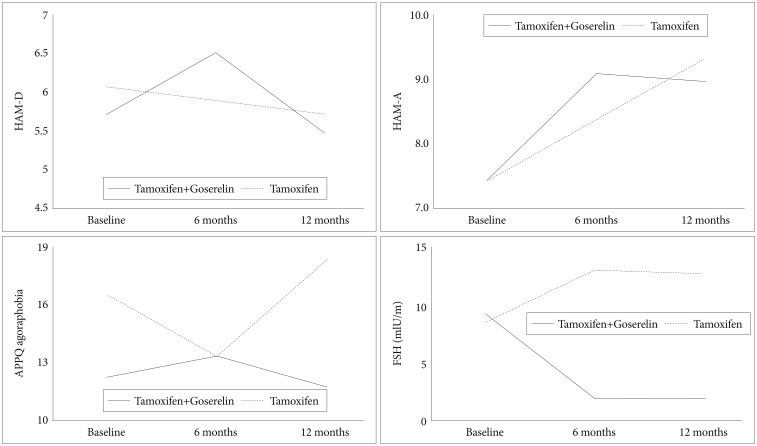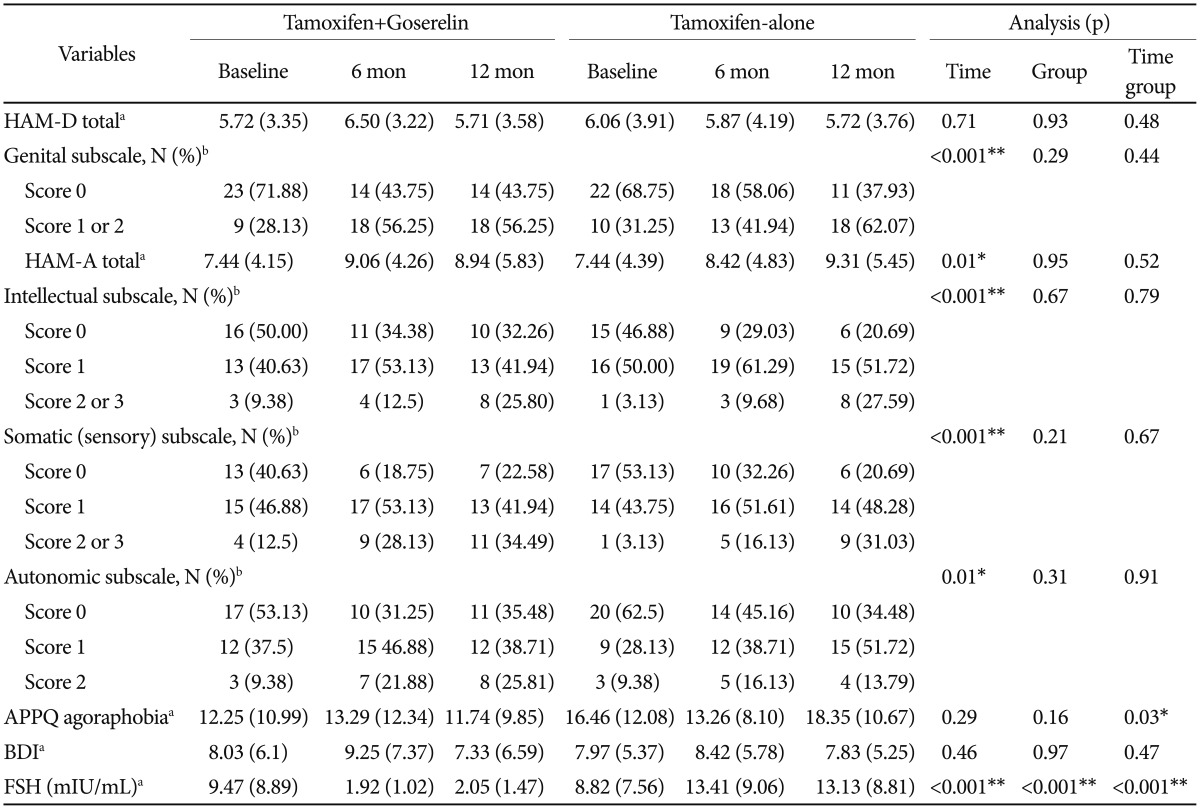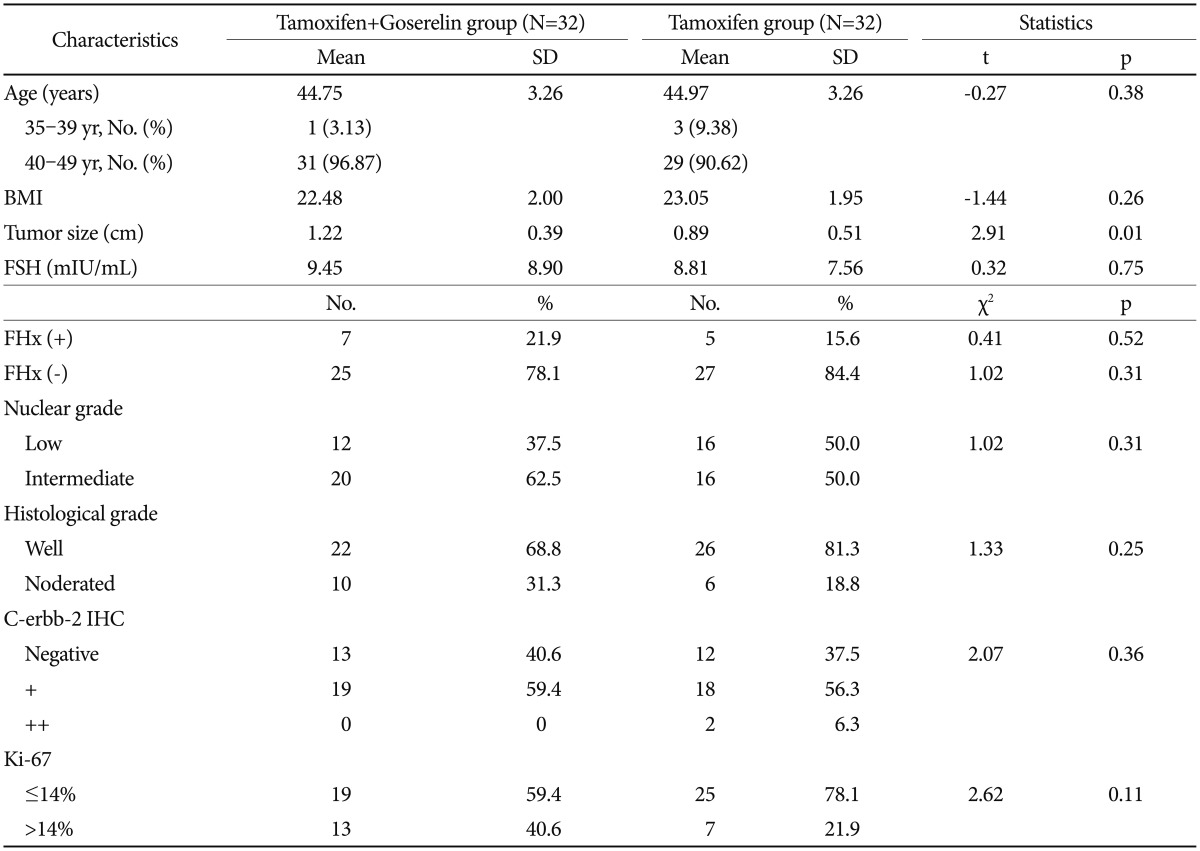1. Dellapasqua S, Colleoni M, Gelber RD, Goldhirsch A. Adjuvant endocrine therapy for premenopausal women with early breast cancer. J Clin Oncol 2005;23:1736-1750. PMID:
15755982.


2. Carlson RW, Allred DC, Anderson BO, Burstein HJ, Carter WB, Edge SB, et al. Breast cancer. J Nat Compr Cancer Network 2009;7:122-192.

3. Burstein HJ, Prestrud AA, Seidenfeld J, Anderson H, Buchholz TA, Davidson NE, et al. American Society of Clinical Oncology clinical practice guideline: update on adjuvant endocrine therapy for women with hormone receptor-positive breast cancer. J Clin Oncol 2010;28:3784-3796. PMID:
20625130.



6. Shapiro CL, Recht A. Side effects of adjuvant treatment of breast cancer. New Eng J Med 2001;344:1997-2008. PMID:
11430330.


7. Metindir J, Aslan S, Bilir G. Ovarian cyst formation in patients using tamoxifen for breast cancer. Jpn J Clin Oncol 2005;35:607-611. PMID:
16254040.



8. Nicholson RI, Walker KJ, Turkes A, Turkes AO, Dyas J, Blamey RW, et al. Therapeutic significance and the mechanism of action of the LH-RH agonist ICI 118630 in breast and prostate cancer. J Steroid Biochem 1984;20:129-135. PMID:
6231416.


9. Moore HC, Unger JM, Phillips KA, Boyle F, Hitre E, Porter D, et al. Goserelin for ovarian protection during breast-cancer adjuvant chemotherapy. New Eng J Med 2015;372:923-932. PMID:
25738668.



10. Robertson JF, Blamey RW. The use of gonadotrophin-releasing hormone (GnRH) agonists in early and advanced breast cancer in pre- and perimenopausal women. Eur J Cancer 2003;39:861-869. PMID:
12706354.


11. Goel S, Sharma R, Hamilton A, Beith J. LHRH agonists for adjuvant therapy of early breast cancer in premenopausal women. Cochrane Database Syst Rev 2009;(4):CD004562PMID:
19821328.



12. Sverrisdottir A, Johansson H, Johansson U, Bergh J, Rotstein S, Rutqvist L, et al. Interaction between goserelin and tamoxifen in a prospective randomised clinical trial of adjuvant endocrine therapy in premenopausal breast cancer. Breast Cancer Res Treat 2011;128:755-763. PMID:
21625929.


13. Francis PA, Regan MM, Fleming GF, Lang I, Ciruelos E, Bellet M, et al. Adjuvant ovarian suppression in premenopausal breast cancer. N Engl J Med 2015;372:436-446. PMID:
25495490.


14. Pagani O, Regan MM, Walley BA, Fleming GF, Colleoni M, Lang I, et al. Adjuvant exemestane with ovarian suppression in premenopausal breast cancer. N Engl J Med 2014;371:107-118. PMID:
24881463.



15. Minton SE, Munster PN. Chemotherapy-induced amenorrhea and fertility in women undergoing adjuvant treatment for breast cancer. Cancer Control 2002;9:466-472. PMID:
12514564.


16. Oh JY, Yu BH, Heo JY, Yoo I, Song H, Jeon HJ. Plasma catecholamine levels before and after paroxetine treatment in patients with panic disorder. Psychiatry Res 2015;225:471-475. PMID:
25529258.


17. Kim B, Kang ES, Fava M, Mischoulon D, Soskin D, Yu BH, et al. Follicle-stimulating hormone (FSH), current suicidal ideation and attempt in female patients with major depressive disorder. Psychiatry Res 2013;210:951-956. PMID:
24080256.


18. Baek JH, Kang ES, Fava M, Mischoulon D, Nierenberg AA, Lee D, et al. Thyroid stimulating hormone and serum, plasma, and platelet brain-derived neurotrophic factor during a 3-month follow-up in patients with major depressive disorder. J Affect Disord 2014;169:112-117. PMID:
25189990.


19. Ganz PA, Greendale GA, Petersen L, Kahn B, Bower JE. Breast cancer in younger women: reproductive and late health effects of treatment. J Clin Oncol 2003;21:4184-4193. PMID:
14615446.


20. Cohen LS, Soares CN, Vitonis AF, Otto MW, Harlow BL. Risk for new onset of depression during the menopausal transition: the Harvard study of moods and cycles. Arch Gen Psychiatry 2006;63:385-390. PMID:
16585467.


21. van Vliet I, de Beurs E. The MINI-International Neuropsychiatric Interview. A brief structureddiagnostic psychiatric interview for DSM-IV en ICD-10 psychiatric disorders. Tijdschr Psychiatr 2007;49:393-397. PMID:
17614093.

22. Hamilton M. Development of a rating scale for primary depressive illness. Br J Soc Clin Psychol 1967;6:278-296. PMID:
6080235.


23. Hamilton M. The assessment of anxiety states by rating. Br J Med Psychol 1959;32:50-55. PMID:
13638508.


24. Beck AT, Ward C, Mendelson M. Beck depression inventory (BDI). Arch Gen Psychiatry 1961;4:561-571. PMID:
13688369.


25. Rapee RM, Craske MG, Barlow DH. Assessment instrument for panic disorder that includes fear of sensation-producing activities: the Albany Panic and Phobia Questionnaire. Anxiety 1994-1995;1:114-122.

26. Reiss S, Peterson RA, Gursky DM, McNally RJ. Anxiety sensitivity, anxiety frequency and the prediction of fearfulness. Behav Res Ther 1986;24:1-8. PMID:
3947307.


27. Hirschfeld RM, Williams JB, Spitzer RL, Calabrese JR, Flynn L, Keck PE Jr, et al. Development and validation of a screening instrument for bipolar spectrum disorder: the Mood Disorder Questionnaire. Am J Psychiatry 2000;157:1873-1875. PMID:
11058490.


28. Angst J, Adolfsson R, Benazzi F, Gamma A, Hantouche E, Meyer TD, et al. The HCL-32: towards a self-assessment tool for hypomanic symptoms in outpatients. J Affect Disord 2005;88:217-233. PMID:
16125784.


29. Lim YJ, Yu BH, Kim JH. Korean Anxiety Sensitivity Index-Revised: its factor structure, reliability, and validity in clinical and nonclinical samples. Depress Anxiety 2007;24:331-341. PMID:
17041921.


30. Lee EH, Kim JH, Yu BH. Reliability and validity of the self-report version of the Panic Disorder Severity Scale in Korea. Depress Anxiety 2009;26:E120-E123. PMID:
19373866.


31. Lee Y, Song J. A study of the reliability and the validity of the BDI, SDS, and MMPI-D scales. Korean J Clin Psychol 1991;10:98-113.
32. Zimmerman M, Martinez JH, Young D, Chelminski I, Dalrymple K. Severity classification on the Hamilton Depression Rating Scale. J Affect Disord 2013;150:384-388. PMID:
23759278.


33. Asmundson GJ, Taylor S, Smits JA. Panic disorder and agoraphobia: an overview and commentary on DSM-5 changes. Depress Anxiety 2014;31:480-486. PMID:
24865357.


34. Azizi-Malekabadi H, Pourganji M, Zabihi H, Saeedjalali M, Hosseini M. Tamoxifen antagonizes the effects of ovarian hormones to induce anxiety and depression-like behavior in rats. Arquivos de Neuro-Psiquiatria 2015;73:132-139. PMID:
25742583.



35. Mook D, Felger J, Graves F, Wallen K, Wilson ME. Tamoxifen fails to affect central serotonergic tone but increases indices of anxiety in female rhesus macaques. Psychoneuroendocrinology 2005;30:273-283. PMID:
15511601.


36. Fallowfield L, Fleissig A, Edwards R, West A, Powles TJ, Howell A, et al. Tamoxifen for the prevention of breast cancer: psychosocial impact on women participating in two randomized controlled trials. J Clin Oncol 2001;19:1885-1892. PMID:
11283119.


37. Ahmann FR, Citrin DL, deHaan HA, Guinan P, Jordan VC, Kreis W, et al. Zoladex: a sustained-release, monthly luteinizing hormone-releasing hormone analogue for the treatment of advanced prostate cancer. J Clin Oncol 1987;5:912-917. PMID:
2953870.


38. Bromberger JT, Kravitz HM, Chang Y, Randolph JF Jr, Avis NE, Gold EB, et al. Does risk for anxiety increase during the menopausal transition? Study of women’s health across the nation. Menopause 2013;20:488-495. PMID:
23615639.



39. Ko CH, Long CY, Chen SY, Chen IJ, Huang TH, Yen JY. Depression, irritability, and anxiety in women with premenstrual dysphoric disorder. Int J Psychiatry Med 2013;46:39-55. PMID:
24547609.


40. Britton JR. Maternal anxiety: course and antecedents during the early postpartum period. Depress Anxiety 2008;25:793-800. PMID:
17397041.


41. Gordon JL, Girdler SS, Meltzer-Brody SE, Stika CS, Thurston RC, Clark CT, et al. Ovarian hormone fluctuation, neurosteroids, and HPA axis dysregulation in perimenopausal depression: a novel heuristic model. Am J Psychiatry 2015;172:227-236. PMID:
25585035.



42. Antoni MH, Wimberly SR, Lechner SC, Kazi A, Sifre T, Urcuyo KR, et al. Reduction of cancer-specific thought intrusions and anxiety symptoms with a stress management intervention among women undergoing treatment for breast cancer. Am J Psychiatry 2006;163:1791-1797. PMID:
17012691.



43. Montgomery J, Brincat M, Tapp A, Appleby L, Versi E, Fenwick P, et al. Effect of oestrogen and testosterone implants on psychological disorders in the climacteric. Lancet 1987;1:297-299. PMID:
2880114.


44. Halbreich U, Kahn LS. Role of estrogen in the aetiology and treatment of mood disorders. CNS drugs 2001;15:797-817. PMID:
11602005.


45. Guimond AJ, Massicotte E, Savard MH, Charron-Drolet J, Ruel S, Ivers H, et al. Is anxiety associated with hot flashes in women with breast cancer. Menopause 2015;22:864-871. PMID:
25608268.


46. Bruno D, Feeney KJ. Management of postmenopausal symptoms in breast cancer survivors. Semin Oncol 2006;33:696-707. PMID:
17145350.


47. Mitchell ES, Woods NF. Hot flush severity during the menopausal transition and early postmenopause: beyond hormones. Climacteric 2015;18:536-544. PMID:
25748168.















